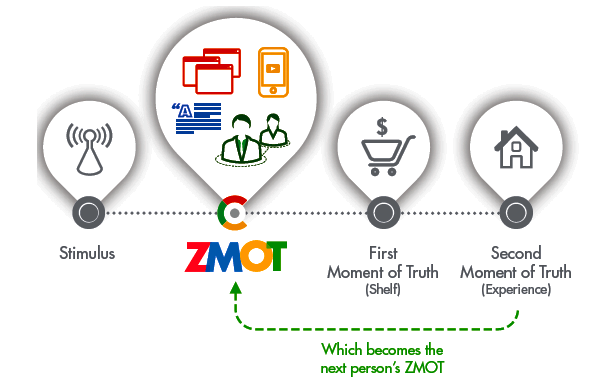Your cart is currently empty!

The Zero Moment of Truth
Sterling Tucker of the Natural Fruit Corporation asked me the other day if I knew about the first and second moments of truth for CPG companies — the famed FMOT and SMOT. The first moment of truth is when a customer decides to buy the item in the store. The second moment of truth is when that customer gets the product home and tries it. The decision and the experience — if the decision isn’t made, your product won’t be purchased; if the experience isn’t good, you’ve lost that customer.
These notions are still valid. However, we now also must be aware of the Zero Moment of Truth: the moment when, thinking about buying your product, your potential customer goes online to do some research. The typical customer no longer thinks, “Hey, a cool new camera! I’ll go down to the camera store and have a look.” Instead, he thinks, “Hey, a cool new camera! I’ll Google it.” That’s the ZMOT.
Depending on your industry, up to 96% of consumers will do research online before buying in a physical store. Most shoppers nowadays have their minds mostly made up when they walk into the shop.
Let’s imagine that you’re a cosmetics company. Your latest potential customer is a 30 year old woman who, perhaps because of the stimulus of magazine ads or a conversation with a friend, decides that it’s time to look into a new skincare product, BB cream, which you have recently added to your product line. If she’s a typical consumer, she’ll use more than 10 sources of information before she actually buys anything. Think of the sources of information she might use in her research:
- a YouTube video showing a beauty guru using a new product
- Google’s search engine results page for “BB cream”
- bloggers’ comparative reviews of BB cream
- customer reviews for specific brands of BB cream
- e-commerce sites’ information on the brands they carry
- social media mentions of the brands she’s now thinking of buying
- review sites, including Amazon and specific make up review sites
- Google SERP for the specific brand she’s thinking about
- the manufacturers’ websites for the brands she’s considering
- sites rating the companies for social responsibility and sustainability
But what if she found, instead, the following sources of information:
- your YouTube video showing your beauty guru using your new product
- Google’s search engine results page for “BB cream,” where, because she has been to your blog several times, your site comes up at the top of her results page
- bloggers’ comparative reviews of BB cream, including your product, since you reach out to bloggers in your space
- customer reviews for specific brands of BB cream, including yours, since you encourage customers to leave reviews on your website and on review sites
- e-commerce sites’ information on the brands they carry, including yours because she is now thinking seriously about buying your brand
- social media mentions of the brands she’s now thinking of buying, including your social media, because she follows you for the fun and useful content you offer her on a daily basis
- review sites, including Amazon and specific make up review sites
- your online ads — which she looks at now even if she usually ignores ads, because she’s interested in the product
- your website, which has great content relating to your new product
- sites rating your company for social responsibility and sustainability
When this customer walks into her local store and heads for the cosmetics aisle, she will already have your product in her mind. You will not really be competing with all the other brands on the shelf. She’ll see your product, recognize the packaging because she has seen it repeatedly online during her research, and pick it up.
Even if she compares your product with others on the shelf, reading the packages and checking prices, she is predisposed toward your product.
Remember, many of the sources of information that show up online for your customer will be sites you control only if you have already been on this customer’s radar. If she’s following your Facebook and Twitter feeds, if she visits your blog, if she sees you on Pinterest, if she reads the reviews at your website — then you’ll dominate the page when she searches for a new product. The new, empowered consumer is in control of the information she receives.
This requires regular, ongoing work on your online presence. That’s what we do, here at Haden Interactive. If you need someone to look after your customers’ ZMOT, give us a call at 479.966.9761 or email Rosie.
by
Tags:

Leave a Reply